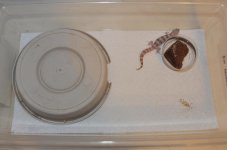thorrshamri
Moderator/The French Viking Moderathorr
1:2 would easily fit in this, species such as brevis or mitranus. The latter are from Central America if I remember well, and need much more moisture than the other species of the genus.


Black Banded Geckos (C. fasciatus) are only found in Mexico and very difficult to get a hold of legally. I am not aware of any in the United States but I am not well-connected.
You can keep the western bandeds (C. variegatus), Texas bandeds (C. brevis) and black bandeds (C. fasciatus) similar to leopard geckos as they are more arid/desert-type species. Once you get into the Central American (C. mitratus) and Yucatans (C. elegans), you will need to adjust for humidity and other things.
I keep groups of one male to up to four female western banded geckos (C. variegatus) together. Putting two adult males together just leads to one of the males stressing out and not doing well. I have mine on a variety of substrates from just sand to mixtures of sand/peat/pebbles. I keep younger animals on paper towels to try to avoid any impaction issues although I have never had any issues with any of my western bandeds.
Here is my setup for an adult trio of San Diego banded gex (C. v. abbotti). Several different hides and a mixture of sand/peat/pebbles as a substrate. That is a sweater box they are in.
View attachment 34819
And for the younger ones, I house them individually in shoe-boxes on paper towels. Here's one of the young Utah bandeds (C. v. utahensis) I am raising up.
View attachment 34820

